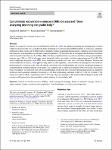Item Infomation
Full metadata record
| DC Field | Value | Language |
|---|---|---|
| dc.contributor.author | Friedrich-W., Wellmer | - |
| dc.contributor.author | Roland W., Scholz | - |
| dc.contributor.author | Dennis, Bastian | - |
| dc.date.accessioned | 2023-04-11T03:07:17Z | - |
| dc.date.available | 2023-04-11T03:07:17Z | - |
| dc.date.issued | 2023 | - |
| dc.identifier.uri | https://link.springer.com/article/10.1007/s13563-023-00368-0 | - |
| dc.identifier.uri | https://dlib.phenikaa-uni.edu.vn/handle/PNK/7750 | - |
| dc.description | CC BY | vi |
| dc.description.abstract | Inspired by a paper by Teseletso and Adachi (Miner Econ 8(10):21, 2021), the hypothesis regarding the declining grade of mined copper ore and its possible use as a guide to the future of ultimate recoverable resources (URRs) is tested. As a time axis, cumulative production is taken. Grades can be either grade of cumulative tonnage or annual production grade. Correlation can be linear (grade and tonnage) or semi-logarithmic (grade linear, tonnage logarithmic). We first show that the assumption that the highest correlation is the best guide to the future may be a fallacy. This is the linear correlation between grades of cumulative tonnage and cumulative tonnages since 1959, i.e., 85% of all copper mined historically with a near-perfect correlation approaching one (R2 = 0.97). This leads to implausibly low results of the URR, clearly demonstrating that this trend must shift in the future. | vi |
| dc.language.iso | en | vi |
| dc.publisher | Springer | vi |
| dc.subject | URRs | vi |
| dc.subject | analyzing declining | vi |
| dc.title | Can ultimate recoverable resources (URRs) be assessed? Does analyzing declining ore grades help? | vi |
| dc.type | Book | vi |
| Appears in Collections | ||
| OER - Kinh tế và Quản lý | ||
Files in This Item:

